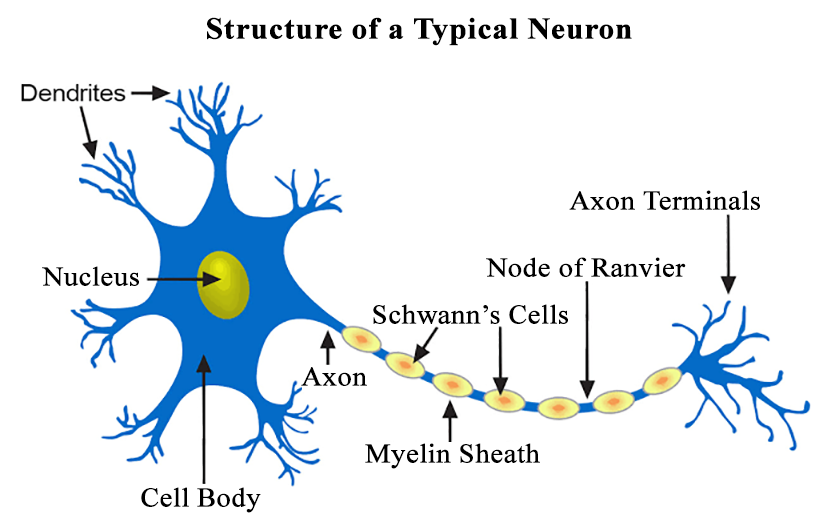
: What is the function of nerve cells?
(a)Nerve cells receive messages from different parts of the body.
(b)Nerves transfer the messages to the brain.
(c)The brain sends commands for the functioning of different organs of the body via nerves.
(d)All of the above
Answer
575.1k+ views
Hint: The nerve cell neurons have to perform a very important function of transferring instructions generated by the brain in the form of nerve impulses, according to which different functions of our body take place.
Complete answer:
-Nerve cells receive messages from different parts of the body and transfer the messages to the brain. The brain sends commands for the functioning of different organs of the body via nerves.
-Whenever a sensory receptor receives information from the environment, the end of the dendrite tip sets of a chemical reaction to create an electrical impulse. This impulse travels from the dendrite to the cyton and then through the axon reaches the axon ends.
-As the message gets transferred from one neuron to another, it finally reaches the muscle cells or glands (effector organ) based on which the impulses will be converted into action.
-Neuron comprises a cyton or cell body which consists of a nucleus, mitochondria, Golgi body, and endoplasmic reticulum. The axon is an extension of the dendrites and it consists of axolemma, myelin sheath, and neurilemma. The small branching of the cyton is the dendrites.

So, the correct answer is “all of the above”
Note: -The mitochondria in the muscle cells are comparatively larger in number to produce energy for muscular action.
-At the end of the axon, the electrical impulse releases some chemicals, these chemicals cross a gap or synapse by creating a potential difference through the accumulation of ions.
-The human body contains about 100 billion neurons in the brain and 13.5 million neurons in the spinal cord.
-Depending upon the location and functions to be performed neurons have different shapes and sizes.
Complete answer:
-Nerve cells receive messages from different parts of the body and transfer the messages to the brain. The brain sends commands for the functioning of different organs of the body via nerves.
-Whenever a sensory receptor receives information from the environment, the end of the dendrite tip sets of a chemical reaction to create an electrical impulse. This impulse travels from the dendrite to the cyton and then through the axon reaches the axon ends.
-As the message gets transferred from one neuron to another, it finally reaches the muscle cells or glands (effector organ) based on which the impulses will be converted into action.
-Neuron comprises a cyton or cell body which consists of a nucleus, mitochondria, Golgi body, and endoplasmic reticulum. The axon is an extension of the dendrites and it consists of axolemma, myelin sheath, and neurilemma. The small branching of the cyton is the dendrites.

So, the correct answer is “all of the above”
Note: -The mitochondria in the muscle cells are comparatively larger in number to produce energy for muscular action.
-At the end of the axon, the electrical impulse releases some chemicals, these chemicals cross a gap or synapse by creating a potential difference through the accumulation of ions.
-The human body contains about 100 billion neurons in the brain and 13.5 million neurons in the spinal cord.
-Depending upon the location and functions to be performed neurons have different shapes and sizes.
Recently Updated Pages
Master Class 12 Business Studies: Engaging Questions & Answers for Success

Master Class 12 Economics: Engaging Questions & Answers for Success

Master Class 12 English: Engaging Questions & Answers for Success

Master Class 12 Maths: Engaging Questions & Answers for Success

Master Class 12 Social Science: Engaging Questions & Answers for Success

Master Class 12 Chemistry: Engaging Questions & Answers for Success

Trending doubts
What is meant by exothermic and endothermic reactions class 11 chemistry CBSE

Which animal has three hearts class 11 biology CBSE

10 examples of friction in our daily life

One Metric ton is equal to kg A 10000 B 1000 C 100 class 11 physics CBSE

1 Quintal is equal to a 110 kg b 10 kg c 100kg d 1000 class 11 physics CBSE

Difference Between Prokaryotic Cells and Eukaryotic Cells




